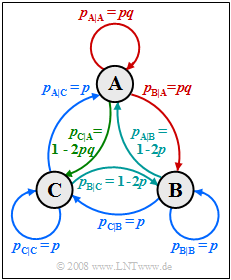Exercise 1.6Z: Ternary Markov Source
The diagram on the right shows a Markov source with $M = 3$ states $\rm A$, $\rm B$ and $\rm C$.
Let the two parameters of this Markov process be:
- $$0 \le p \le 0.5 \hspace{0.05cm},\hspace{0.2cm}0 \le q \le 1 \hspace{0.05cm}.$$
Due to the Markov property of this source, the entropy can be determined in different ways:
- One calculates the first two entropy approximations $H_1$ and $H_2$. Then the following applies to the actual entropy:
- $$H= H_{k \to \infty} = 2 \cdot H_{\rm 2} - H_{\rm 1} \hspace{0.05cm}.$$
- However, according to the "direct calculation method", the entropy can also be written as follows (nine terms in total):
- $$H = p_{\rm AA} \cdot {\rm log_2}\hspace{0.1cm}\frac {1}{ p_{\rm A\hspace{0.01cm}|\hspace{0.01cm}A}} + p_{\rm AB} \cdot {\rm log_2}\hspace{0.1cm}\frac {1}{ p_{\rm B\hspace{0.01cm}|\hspace{0.01cm}A}} + \ \text{...} \hspace{0.05cm}, \ \text{wobei} \ p_{\rm AA} = p_{\rm A} \cdot p_{\rm A\hspace{0.01cm}|\hspace{0.01cm}A} \hspace{0.05cm},\hspace{0.2cm} p_{\rm AB} = p_{\rm A} \cdot p_{\rm B\hspace{0.01cm}|\hspace{0.01cm}A} \hspace{0.05cm}, \ \text{...}$$
Hint:
- The exercise belongs to the chapter Discrete Sources with Memory.
- Reference is made in particular to the page Non-binary Markov sources.
- For all entropies, add the pseudo-unit "bit/symbol".
Questions
Solution
- $p_{\rm A} = p_{\rm A|A} = p_{\rm A|B} = p_{\rm A|C} = 1/3$,
- $p_{\rm B} = p_{\rm B|A} = p_{\rm B|B} = p_{\rm B|C} = 1/3$,
- $p_{\rm C} = p_{\rm C|A} = p_{\rm C|B} = p_{\rm C|C} = 1/3$.
From this, the values we are looking for can be determined:
- For example, from $p_{\rm C|C} = 1/3$ one obtains the value $p \hspace{0.15cm}\underline{= 1/3}$.
- If one also takes into account the relationship $p_{\rm A|A} = p \cdot q$, then $q \hspace{0.15cm}\underline{= 1}$.
- This gives the maximum entropy $H_\text{max} ={\rm log_2} \ 3\hspace{0.15cm}\underline{= 1.585\ \rm bit/symbol}$.
(2) With the parameter values $p = 1/4$ and $q = 1$ , we obtain the adjacent transition diagram, which has the following symmetries:
- $p_{\rm A|A} = p_{\rm B|B} = p_{\rm C|C} = 1/4$ (marked in red),
- $p_{\rm A|B} = p_{\rm B|C} = p_{\rm C|A} = 1/2$ (marked in green),
- $p_{\rm A|C} = p_{\rm B|A} = p_{\rm C|CB} = 1/4$ (marked in blue).
It is obvious that the symbol probabilities are all equal:
- $$p_{\rm A} = p_{\rm B} = p_{\rm C} = 1/3 \hspace{0.3cm} \Rightarrow \hspace{0.3cm} H_1 = {\rm log_2}\hspace{0.1cm} 3 \hspace{0.15cm} \underline {= 1.585 \,{\rm bit/symbol}} \hspace{0.05cm}.$$
(3) For the second entropy approximation one needs $3^2 = 9$ joint probabilities.
- Using the result from (2) , one obtains for this:
- $$p_{\rm AA} = p_{\rm BB}= p_{\rm CC}= p_{\rm AC}=p_{\rm BA}=p_{\rm CB}=1/12 \hspace{0.05cm},\hspace{0.5cm} p_{\rm AB} = p_{\rm BC}=p_{\rm CA}=1/6$$
- $$\Rightarrow \hspace{0.2cm} H_2 = \frac{1}{2} \cdot \left [ 6 \cdot \frac{1}{12} \cdot {\rm log_2}\hspace{0.1cm} 12 + 3 \cdot \frac{1}{6} \cdot {\rm log_2}\hspace{0.1cm} 6 \right ] = \frac{1}{4} \cdot {\rm log_2}\hspace{0.1cm} 4 + \frac{1}{4} \cdot {\rm log_2}\hspace{0.1cm} 3 + \frac{1}{4} \cdot {\rm log_2}\hspace{0.1cm} 2 + \frac{1}{4} \cdot {\rm log_2}\hspace{0.1cm} 3 = \frac{3}{4} + \frac{{\rm log_2}\hspace{0.1cm} 3}{2} \hspace{0.15cm} \underline {= 1.5425 \,{\rm bit/symbol}} \hspace{0.05cm}.$$
(4) Due to the Markov property of the source, the following holds true:
- $$H = H_{k \to \infty}= 2 \cdot H_2 - H_1 = \big [ {3}/{2} + {\rm log_2}\hspace{0.1cm} 3 \big ] - {\rm log_2}\hspace{0.1cm} 3\hspace{0.15cm} \underline {= 1.5 \,{\rm bit/symbol}} \hspace{0.05cm}.$$
- One would arrive at the same result according to the following calculation:
- $$H= p_{\rm AA} \cdot {\rm log_2}\hspace{0.1cm}\frac {1}{ p_{\rm A\hspace{0.01cm}|\hspace{0.01cm}A}} + p_{\rm AB} \cdot {\rm log_2}\hspace{0.1cm}\frac {1}{ p_{\rm B\hspace{0.01cm}|\hspace{0.01cm}A}} + ... \hspace{0.1cm}= 6 \cdot \frac{1}{12} \cdot {\rm log_2}\hspace{0.1cm} 4 + 3 \cdot \frac{1}{16} \cdot {\rm log_2}\hspace{0.1cm} 2 \hspace{0.15cm} \underline {= 1.5 \,{\rm bit/symbol}} \hspace{0.05cm}.$$
(5) From the adjacent transition diagram with the current parameters, one can see that in the case of stationarity $p_{\rm B} = 0$ will apply, since $\rm B$ can occur at most once at the starting time.
- So there is a binary Markov chain with the symbols $\rm A$ and $\rm C$ .
- The symbol probabilities are therefore given by:
- $$p_{\rm A} = 0.5 \cdot p_{\rm C} \hspace{0.05cm}, \hspace{0.2cm}p_{\rm A} + p_{\rm C} = 1 \hspace{0.3cm} \Rightarrow \hspace{0.3cm} p_{\rm A} = 1/3 \hspace{0.05cm}, \hspace{0.2cm} p_{\rm C} = 2/3\hspace{0.05cm}. $$
- This gives the following probabilities:
- $$p_{\rm A\hspace{0.01cm}|\hspace{0.01cm}A} \hspace{0.1cm} = \hspace{0.1cm}0\hspace{0.7cm} \Rightarrow \hspace{0.3cm} p_{\rm AA} = 0 \hspace{0.05cm},$$
- $$ p_{\rm A\hspace{0.01cm}|\hspace{0.01cm}C} =1/2\hspace{0.3cm} \Rightarrow \hspace{0.3cm} p_{\rm CA} = p_{\rm C} \cdot p_{\rm A\hspace{0.01cm}|\hspace{0.01cm}C} = 2/3 \cdot 1/2 = 1/3 \hspace{0.05cm},\hspace{0.2cm}{\rm log_2}\hspace{0.1cm}(1/p_{\rm A\hspace{0.01cm}|\hspace{0.01cm}C} )= 1\hspace{0.05cm},$$
- $$ p_{\rm C\hspace{0.01cm}|\hspace{0.01cm}A} =1\hspace{0.7cm} \Rightarrow \hspace{0.3cm} p_{\rm AC} = p_{\rm A} \cdot p_{\rm C\hspace{0.01cm}|\hspace{0.01cm}A} = 1/3 \cdot 1 = 1/3 \hspace{0.05cm},\hspace{0.61cm}{\rm log_2}\hspace{0.1cm}(1/p_{\rm C\hspace{0.01cm}|\hspace{0.01cm}A} )= 0\hspace{0.05cm},$$
- $$ p_{\rm C\hspace{0.01cm}|\hspace{0.01cm}C} =1/2\hspace{0.3cm} \Rightarrow \hspace{0.3cm} p_{\rm CC} = p_{\rm C} \cdot p_{\rm C\hspace{0.01cm}|\hspace{0.01cm}C} = 2/3 \cdot 1/2 = 1/3\hspace{0.05cm},\hspace{0.2cm}{\rm log_2}\hspace{0.1cm}(1/p_{\rm C\hspace{0.01cm}|\hspace{0.01cm}C} )= 1 $$
- $$\Rightarrow \hspace{0.25cm} H = p_{\rm AA} \cdot {\rm log_2}\hspace{0.1cm}\frac {1}{ p_{\rm A\hspace{0.01cm}|\hspace{0.01cm}A}} +p_{\rm CA} \cdot {\rm log_2}\hspace{0.1cm}\frac {1}{ p_{\rm A\hspace{0.01cm}|\hspace{0.01cm}C}}+ p_{\rm AC} \cdot {\rm log_2}\hspace{0.1cm}\frac {1}{ p_{\rm C\hspace{0.01cm}|\hspace{0.01cm}A}} + p_{\rm CC} \cdot {\rm log_2}\hspace{0.1cm}\frac {1}{ p_{\rm C\hspace{0.01cm}|\hspace{0.01cm}C}}= 0 + 1/3 \cdot 1 + 1/3 \cdot 0 + 1/3 \cdot 1 \hspace{0.15cm} \underline {= 0.667 \,{\rm bit/symbol}} \hspace{0.05cm}.$$

